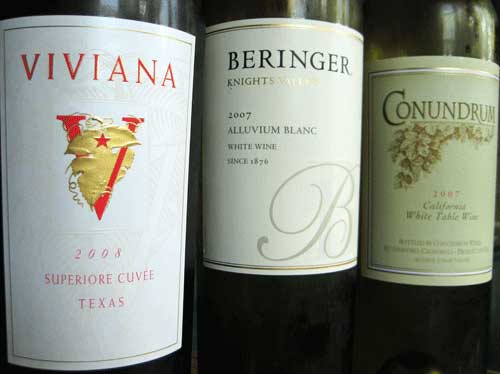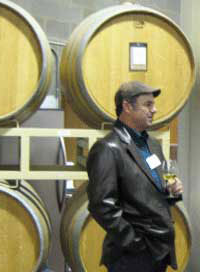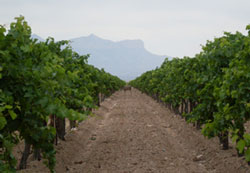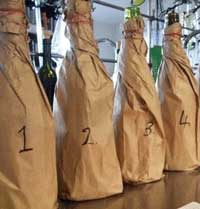
A Comparative Tasting: Premium White Blends – Viviana, Alluvium Blanc and Conundrum
Viviana – A wine alive and well with Texas heat…
The hot days of Texas summer are upon us. What better thing to do than get your outdoor chores done by noon, get showered up and then stay inside in “air-conned” comfort. Perhaps, the only thing better is to also get in a few tastings of some cool white wines. The tasting experience that follows exposure to our summertime weather makes you appreciate wines with the ability to quench; quench the heat of summer and also the heat of our spicy regional cuisines like Tex-Mex, Southwestern, Creole/Cajun and even Pan Asian.
 This was the context for my recent tasting of three premium white table wines. All were fascinating and somewhat exotic blends that prompt the near-philosophical questions as to how the blends were developed and how their names were derived.
This was the context for my recent tasting of three premium white table wines. All were fascinating and somewhat exotic blends that prompt the near-philosophical questions as to how the blends were developed and how their names were derived.
The focus of my attention was the newly released 2008 Viviana, the Yin/Yang counterpart of the premium Mediterranean red-blend, Viviano from Llano Estacado in Lubbock, Texas (www.llanowine.com). This wine was made by Llano Estacado’s winemaker Chris Hall and is a proprietary blend of the aromatic northern European Gewurztraminer conjoined with equally perfumed Mediterranean Muscat Canelli and Viognier. Riesling and Chardonnay play their part offering wine structure, mouth feel and body. In this case, no one varietal greatly dominates in percentage.
Viviana’s partners in this taste pairing were two highly rated premium white blends of equal creativity from California: Beringer (www.beringer.com) Knights Valley 2007 Alluvium Blanc by winemaker Laurie Hook, and the 2007 Conundrum (www.conundrum.com) by winemaker Jon Bolta and from the distinguished Wagner family of Caymus Vineyards. Alluvium starts with a conventional white Bordeaux blend of Sauvignon Blanc, Semillon and Chardonnay and then adds a pinch of Viognier. Conundrum’s approach is also based on Sauvignon Blanc, Chardonnay and Semillon then follows it with less conventional additions of Muscat Canelli and Viognier. Recent vintages of both Conundrum and Alluvium Blanc wines have garnered ratings from Wine Spectator and Wine Advocate in the range of 89-92.
How will Llano Estacado’s new Viviana compare?
The Tasting
The tasting method was simple. Each wine was tasted individually, and then tasted again while pairing with three food preparations: (1) Antipasti of cheese, olives and salami; (2) Cajun spicy shrimp; (3) baked chicken served au jus.
All three wines were exceptional when tasted alone, each with its own particular personality. The Alluvium Blanc was perceived to be the driest of the three wines followed by Viviana still under 1 percent residual sugar (R.S.). The sweetest wine was the Conundrum estimated to be over 1.5 percent R.S.
2008 Viviana – Light straw color with a slight golden-peach hue likely gained from the Gewurztraminer and Viognier. The nose was dominated by honeysuckle, tropical fruits and hint of musk followed by a citrus rush of lemon-lime with a lengthy finish. Most notable was the silky feel and inherent crispness of the wine, intermingled with perception of honeyed citrus skins.
2007 Alluvium Blanc – The light straw color was followed by dominance of toasted oak on the nose overlaying lemon citrus and green apple aromas and flavors with a snappy tart and dry mineral finish.
2007 Conundrum – Straw colored it offered a floral nose with hints of jasmine and peach. Flavors follow of honeyed stone fruits and a crisp citrus finish carried by the lingering sweetness.
In this tasting panel, all three wines received very similar total scoring based on the U.C. Davis 20-point scale. These ratings were in the range 17-18 (to close to separate) and very much in line with the 88-92 on the Wine Spectator or Enthusiast scales.
From Summer Heat to a Springtime Chill
 Following the tasting on this hot summer day, I flashed back to my first taste of the Viviana during my Texas High Plains trip from March of this year. It was a cold, blowy and icy day hovering around the freezing mark, a far cry from this week’s triple digit readings. I had a chance to sit down for a “technical tasting” with Llano Estacado winemaker Chris Hall and Vice President Executive Winemaker (and California ex-pat) Greg Bruni who explained the process in Viviana’s development. It appears that 2007 was the year to experiment and set their sights set on a commercial vintage of Viviana the following year.
Following the tasting on this hot summer day, I flashed back to my first taste of the Viviana during my Texas High Plains trip from March of this year. It was a cold, blowy and icy day hovering around the freezing mark, a far cry from this week’s triple digit readings. I had a chance to sit down for a “technical tasting” with Llano Estacado winemaker Chris Hall and Vice President Executive Winemaker (and California ex-pat) Greg Bruni who explained the process in Viviana’s development. It appears that 2007 was the year to experiment and set their sights set on a commercial vintage of Viviana the following year.
Chris and Greg explained that, in 2007, they had a relatively large harvest of white varietals. This opportunity facilitated their blending trials to examine the potential range of aromatics, color and flavor while working with several white varietals that they felt did particularly well in Texas. Chris found that they could produce the wine with desirable color, aroma and flavor characteristics while obtaining a natural acid balance.
 According to Greg, “What you taste in Viviana is a wine that expresses it natural elements – The terroir of the grapes grown in Texas without manipulation or interference. These grapes were grown in a most unusual place; the Monte Sec Vineyard located about 25 miles from the Guadalupe Mountains on the eastern slope of the Chihuahuan Desert near Del City, Texas. The five grape varietals found in Viviana were exposed to the influences of the desert sun and soil, and cool nights that make for the distinctive terroir expressed by this wine.” The thought of these grapes basking in the hot desert sun brought me back me to the summertime sizzle again with a need for further quenching.
According to Greg, “What you taste in Viviana is a wine that expresses it natural elements – The terroir of the grapes grown in Texas without manipulation or interference. These grapes were grown in a most unusual place; the Monte Sec Vineyard located about 25 miles from the Guadalupe Mountains on the eastern slope of the Chihuahuan Desert near Del City, Texas. The five grape varietals found in Viviana were exposed to the influences of the desert sun and soil, and cool nights that make for the distinctive terroir expressed by this wine.” The thought of these grapes basking in the hot desert sun brought me back me to the summertime sizzle again with a need for further quenching.
See http://www.llanowine.com/2008VIVIANA.aspx for details on Viviana’s specifications.
The Food Pairing
At this point, I paired the wines with food and had some fascinating observations:
While all three wines were excellent premium summertime quaffs, each had a special moment with one or more of the three food preparations; antipasti, Cajun spicy shrimp and baked chicken. By far, the most food-flexible wine was the Viviana due to its balanced acidity with just the right hint of sweetness that made the wine pliable against a range of foods (even spicy). The acidity kept it crisp and fresh on the palate. The Viviana held my interest though all three preparations, providing good accompaniment with antipasti and chicken, but it especially produced a savory experience with the spicy shrimp. This gave me other thoughts of pairing it with a range of dishes from chicken tamales to Asian curries.
The Alluvium Blanc relished its pairing with the antipasti and baked chicken, but turned bitter against the spicy shrimp that seemed to add to the “heat” of the dish, likely the result of the oak aging. My recommendation is that this wine should be paired with more conventional and sauced fish, chicken and pork dishes, and it will do nicely. As mentioned, Conundrum was readily quaffable, likely due to its higher level of sweetness. It also did very well with the spicy shrimp and reasonably well with the other preparations with the exception of antipasti. However, the sweetness eventually became tiresome over time during the tasting. This wine would be best served before or after dinner imbibed with spicy hors d’oeuvres or slices of ripe stone-fruit and berries.
Other Considerations
I believe that the 2008 Viviana is a snapshot of the wine future of Texas. Texas is just NOT Chardonnay country. It is generally classified as a warm to hot growing region with a variable climate. In fact, someone once told me that Texas doesn’t even have a climate. It only has weather, and highly changeable weather, at that! This makes consistent year-to-year grape production a challenge, and so it was in some parts of Europe, too. We just haven’t had the benefit of 500 to 1000 years of experience gained by our European breathern in adaptive selection of varietals and vineyard methods. Another issue in Texas is the short hang time for grapes due to rapid grape ripening in the hot Texas sun.
Most wine producing regions in the same situation as Texas like the regions in the southern Rhone Valley, Italy, Spain, the Mendoza of Argentina, and even parts of Australia, overcome these problems by basing their wines on blends of anywhere from two to thirteen different varietals. This approach generally improves wine characteristics and year-to-year flexibility in wine production with the added benefit of better brand continuity on market shelves no matter what the weather may bring.
Viviana offers Texas a different approach to making a premium white wine. It is not from the classic Chardonnay mold as is commonly used in Europe and California. It is a step-out emphasizing a blend of aromatic grapes that do well in Texas with the flexibility to work with the warm and changeable Texas weather. It makes good wine sense, good business sense, but best of all it makes sense pairing with our spicy regional cuisines.
 Final Analysis: Prove it Yourself
Final Analysis: Prove it Yourself
Prove to yourself and friends how good a Texas wine like Viviana can be. Open and then brownbag two bottles of wine; Viviana and the other Conundrum or similar quality white wine. Select someone to pour the wine blind and then have the others taste the wines, not knowing what they are. My experience suggests that three out of four people will chose the Viviana from Texas versus Conundrum, a best-selling premium white wine from California. Let me know your results (agree or disagree) by either commenting on this blog or email me at russ@vintagetexas.com.
The Blogger’s Notes
Google can be a wonderful thing particularly when confronted with a word or phrase for the first time. Here are a few of my notes on what you find searching the word “Viviana”.
The meaning of the name Viviana is “Alive” and its origin is from Italy.
Viviana Llano is an actual person with a Facebook page.
Viviana is the name of a Venezuelan TV show host and former beauty queen (Viviana Gibelli) with a penchant for bikinis and hot tubs on her show.
Viviana is a 1916 short drama film directed by B. Reeves Eason.
Want tango lessons? Contact Viviana Levinson, tango instructor.

Be the first to comment